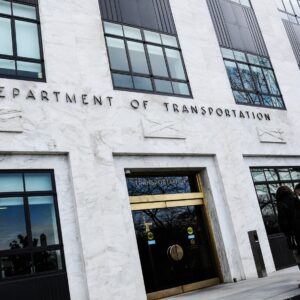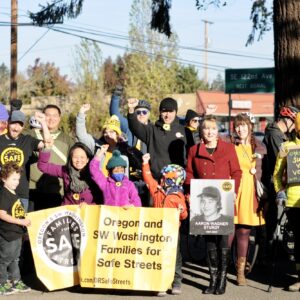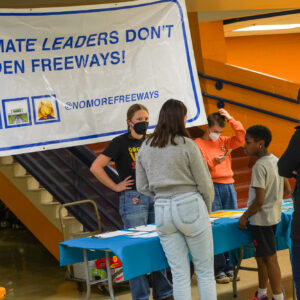The Coalition for a Livable Future is a Portland-based non-profit that works with over 90 separate organizations to “promote healthy and sustainable communities”.
In the recent issue of their Connections Journal newsletter, CLF Policy Director Mara Gross pens a cautionary article about the impacts on greenhouse gas emissions inherent in the current plans for a new I-5 bridge over the Columbia River.

In The Columbia River Crossing’s Carbon Tire-Print (download PDF), Gross writes that the $4.2 billion (estimated) project is an,
“unprecedented opportunity to plan a transportation project in a way that minimizes its global warming impact.”
Gross writes that “it’s unclear why we need a 10 to 12-lane bridge [one of the options on the table],” and cites numerous studies that demonstrate adding road capacity does not help relieve congestion. From the article:
“When road capacity is increased, congestion is temporarily reduced, but new demand quickly increases the congestion again because people make trips they previously would not have made.”
According to Gross, if Oregon and Washington hope to live up to climate change goals adopted by the Governor’s Advisory Group on Global Warming, this project should go through more analysis. She cites an Oregon Department of Energy study that estimated that 38% of Oregon’s CO₂emissions (the primary cause of greenhouse gases) come from vehicle exhaust and writes,
“…we haven’t seen any meaningful analysis of future land use patterns we might expect to see in Clark County if we build a big bridge. The CRC staff should study how adding lanes may lead to new low-density development on the urban fringe and increased emissions…a bridge that encourages more cars and increased vehicle miles will erase gains from increased fuel efficiency and make it much harder to reach our global warming goals.”
Oregon Governor Ted Kulongoski seems to be in line with the CLF’s concern about the project. In a recent story in the Columbian newspaper he said,
“Any time today that you’re talking about a transportation project, particularly in a large metropolitan area…you’d better look at the issues around global warming and around sustainability. You have to look at urban transportation differently than in other places.”
The CRC Task Force met in Vancouver last tonight where they discussed a draft of their Locally Preferred Alternative, presented environmental findings, and discussed the Draft Environment Impact Statement (DEIS), which will be released for public comment in February and March.






Thanks for reading.
BikePortland has served this community with independent community journalism since 2005. We rely on subscriptions from readers like you to survive. Your financial support is vital in keeping this valuable resource alive and well.
Please subscribe today to strengthen and expand our work.
Most of the articles I\’ve read, albeit boiled down versions for us stupid people, talk about congestion in terms of noncommercial traffic – commuters and the like. What\’s driving the bridge construction is commercial traffic. I-5 is the primary access up and down the west coast for trucks and that bottleneck supposedly impacts the flow of goods.
Commercial traffic is about 10% and half of that has its origin/destination north of I-205 split and/or south of the merge in Wilsonville. These choose I-5 over I-205. The congestion in I-5 is due to commuters in single occupancy vehicles with no other option…limited transit, no HOV lane (southboud), pathetic bike/walk facilities, etc.
See my column in the December 28, 2007 Portland Tribune…at their website under \”opinion.\” Tolling now would solve the problem in a flash.
I don\’t understand the interest in building a 10 lane bridge. What good will 5 lanes in each direction do if there are only 3 lanes in each direction going in and out of Portland? (2 lanes south bound at the Delta right now, but I assume there are plans to fix that soon.)
Traffic will just back up at the choke points, and in the south bound case will back up to the bridge and all 5 lanes will come to a halt, just like they do now.
Northbound will go the same speed it does now through the 3 lane sections then speed up when there are more lanes. But so what? The gain will almost negligible.
Let us not forget that no matter what they do with the bridge, there is still the matter of I-5 between the bridge and downtown. There is limited additional lane capacity here, so even if we put in ten lanes in both directions we\’d still have a bottleneck through pretty much all of Portland. We need to reduce demand, not increase capacity, if we are to address congestion. If we don\’t include the MAX and better bicycle/pedestrian facilities in this project…let\’s not even go there. Adding a toll tied to congestion pricing could do that, and might help fund improvements too.
I\’m really thankful someone is pointing out that this project is 180 degrees away from both States\’ stated policy of reducing greenhouse gas emissions. By the way, transportation is the single largest source of such emissions in both states.
And most trips in both states are under 20 miles. If only we had an efficient, emissions-free mode of transportation for such trips…
Thank G-d our states leaders are seeing the lack of intelligence in this proposal. Most states follow expanded road capacity without any forethought. We are lucky that this dialogue is even on the table. Keep up the critical thinking. 🙂
Not saying I agree with the 10-12 lane option, \’cause I don\’t, but what the CRC claims is that the extra lanes are to alleviate the choke points getting ON I-5 at Marine and Columbia, and I guess SR14. And as Scott said in #1, this has to do with Freight. Port of Portland uses these roads to access I-5, and it\’s the 3rd largest port on the W coast.
That being said, the exisitng bridge needs upgrading or replacing eventually, and this will have improved bike/ped access, and light rail (I hope). I just wish it was a 6 lane bridge.
\”…CRC claims is that the extra lanes are to alleviate the choke points getting ON I-5 at Marine and Columbia, and I guess SR14.\”
This might work heading north.
It won\’t work heading south. Once traffic backs up from the choke point to the bridge, it won\’t matter how many lanes there are on the bridge and where the on ramps are.
Why does a new bridge have to end up looking like the west bound approach to the Bay Bridge in Oakland? Thousands of hectares of concrete.
It is time to dig out that \’70s map of Oregon. The one that shows I-5 going around the entire state.
Thank you for the clarification.
Is this bridge proposal a step towards expanding I-5 through the city? An argument against that expansion now could include its inefficacy due to the bottleneck at the bridge. Build new bridges and…
Any read the story on the proposed bridge in the O today? The task force is considering a toll for peak and nonpeak use of the bridge. Return rush hour users would be charged over $5 a day. Of course if this goes through, they might consider slapping a smaller toll on I-205 as well so it doesn\’t shift the numbers to that bridge.
http://www.oregonlive.com/news/oregonian/index.ssf?/base/news/1201071301222440.xml&coll=7
Scott #10:
My opinion – If a 10-lane bridge is built, then the \”perfect\” reason exists to increase the number of lanes to 10 throughout the whole I-5 corridor through Portland.
This bridge is only the tip of the iceberg in regards to how some people want to see the region develop.
I really appreciate the Coalition for a Livable Future\’s work and concerns on this.
Thank you!
Other recent discussions about the CRC project solution causing problems in the future…and not meeting WA and OR goals for emissions reductions…where is the left hand and the right hand?
http://www.sightline.org/research/energy/res_pubs/analysis-ghg-roads
Perhaps it should be a phased project:
1) complete planned Delta Park work (3 lanes)
2) create a regional HOV/ HOT lane north and south with a bridge toll for earthquake upgrade (and 205 MAX work)
3) build local access mulitmodal bridges to Hayden Island from Vancouver and Expo Center (and close I-5 ramps to this island) with MAX to City Center Vancouver
– relocate SR-14 ramps away from bridge
– close 6th Street on Ramp
4) freight rail upgrade of the rail bridge (2 track), [perhaps include as part of local arterial bridge and Portland Port redevelopment on Hayden Is.]
5) then and only then work on adding new car (SOV) capacity to the bridge (aka \’12 lanes\’)
http://www.sightline.org/research/energy/res_pubs/climate-analysis-gge-new-lanes-10-07
http://www.sightline.org/daily_score/archive/2008/01/31/wider-roads-don-t-protect-the-climate-duh